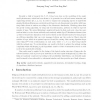Free Online Productivity Tools
i2Speak
i2Symbol
i2OCR
iTex2Img
iWeb2Print
iWeb2Shot
i2Type
iPdf2Split
iPdf2Merge
i2Bopomofo
i2Arabic
i2Style
i2Image
i2PDF
iLatex2Rtf
Sci2ools
PDCAT
2005
Springer
2005
Springer
Optimal Routing in a Small-World Network
Recently a bulk of research [14, 5, 15, 9] has been done on the modelling of the smallworld phenomenon, which has been shown to be pervasive in social and nature networks, and engineering systems [16, 1, 2, 11]. In order to examine the navigating aspects of small-world graphs, Kleinberg [9] proposes a network model based on a d-dimensional torus lattice with longrange links chosen at random according to the d-harmonic distribution. Kleinberg shows that the greedy routing algorithm, by using only local information, performs in O(lg2 n) expected number of hops. We extend Kleinberg’s small-world model in that each node x has two more random links to nodes chosen uniformly and randomly within (lg n) 2 d Manhattan distance from x, where d denotes the dimension of the model. Based on this extended model, we then propose an oblivious algorithm that can route messages between any two nodes in O(lg n) expected number of hops, which is an optimal expected bound for routing. Our routing algori...
Distributed And Parallel Computing | Kleinberg’s Small-world Model | PDCAT 2005 | Routing Algorithm | Small-world Networks |
| Added | 28 Jun 2010 |
| Updated | 28 Jun 2010 |
| Type | Conference |
| Year | 2005 |
| Where | PDCAT |
| Authors | Jianyang Zeng, Wen-Jing Hsu |
Comments (0)

